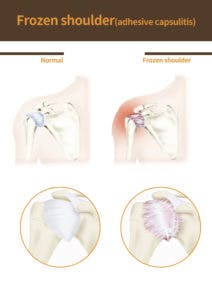Stiffness from a frozen shoulder can last 1 to 3 years. Performing regular home exercises can expedite your recovery. As mentioned in a previous article, the exercise program must be individually tailored and match the stage of the disorder.
We recommend gentle exercises with minimal pain early during the freezing stage. Increase the intensity and volume of stretching during the frozen stage. However, you must always respect pain. During the thawing stage, expect pain during exercise as long as it dissipates soon afterward.
The frozen shoulder exercises that follow in this article are examples of those commonly prescribed by our physical therapists. The effectiveness of frozen shoulder exercises is enhanced by combining them with manual physical therapy.

Supine Shoulder Flexion
Performing stretching exercises in the lying position will minimize the effects of gravity. This results in less pain and improved range of motion.
Begin lying on your back with your hips and knees bent. With your uninvolved hand grasp your wrist of the involved side. Use the uninvolved arm to passively lift your involved arm overhead. Keep your elbow straight. At the onset of mild discomfort or a stretch, pause for 5 to 10 seconds. Perform 10 repetitions.
We prescribe this exercise during the early freezing stage of a frozen shoulder. As your pain begins to diminish progress by increasing the duration of the stretch up to 30 seconds.
Supine Shoulder External Rotation
Begin lying on your back with a small pillow or towel roll under your upper arm. Hold a cane, golf club, or similar object with both hands. Use your uninvolved arm to passively rotate your involved arm out to the side. Maintain your elbow at a 90-degree angle throughout the exercise. At the onset of mild discomfort or a stretch, pause for 5 to 10 seconds. Perform 10 repetitions.
We prescribe this exercise during the freezing stage of a frozen shoulder. As pain diminishes the exercise is progressed by increasing the duration of the stretch up to 30 seconds.
Standing Shoulder Extension
Restoring the ability to reach behind your body is important for everyday living. This takes repetition and time. Be patient. Standing shoulder extension with a cane or golf club is a great starting point.
Stand tall holding a cane behind your body with your arms straight. Maintain both elbows straight and lift the cane backward until mild discomfort or a stretch is felt. Pause in this position for 5 to 10 seconds. Perform 10 repetitions.
We prescribe this exercise during the freezing stage of a frozen shoulder. As pain diminishes the exercise progresses to the cross-body or sleeper stretch described below.
Cross Body Stretch
This stretch addresses tightness in the back of your shoulder. It is most appropriate if you are in the frozen and thawing stages of a frozen shoulder.
Perform this stretch lying on your involved side with your hips and knees bent. Position your involved shoulder and elbow in 90 degrees of flexion. Gently pull your elbow across your body. Hold this position for 30 seconds once you feel a mild stretch on the outside or back part of your shoulder. Perform this stretch 2-3 times each session.
Sleeper Stretch
The sleeper stretch is effective for improving your ability to reach behind your back. Difficulty with dressing behind your back is a common complaint for people with a frozen shoulder.
For this stretch, assume the same starting position as the cross-body stretch. Next, gently move your wrist and forearm down towards the table. Hold this position once you feel a mild stretch on the outside or back part of your shoulder. Perform this stretch 2-3 times each session. This stretch is most appropriate if you are in the thawing stage of a frozen shoulder.
Get More Help “Thawing” Your Frozen Shoulder
Patience and persistence are the keys to success with frozen shoulder exercises. The rate of recovery from a frozen shoulder can only be increased to a certain point. Overly aggressive stretching early when pain levels are high will prolong your recovery. Conversely, infrequent or painless stretching, later on, will result in incomplete recovery. Dealing with a frozen shoulder is a marathon, not a sprint.
Team up with your physical therapist so you can plan the exercise strategy that is best for you. Give us a call if you would like help getting started.


